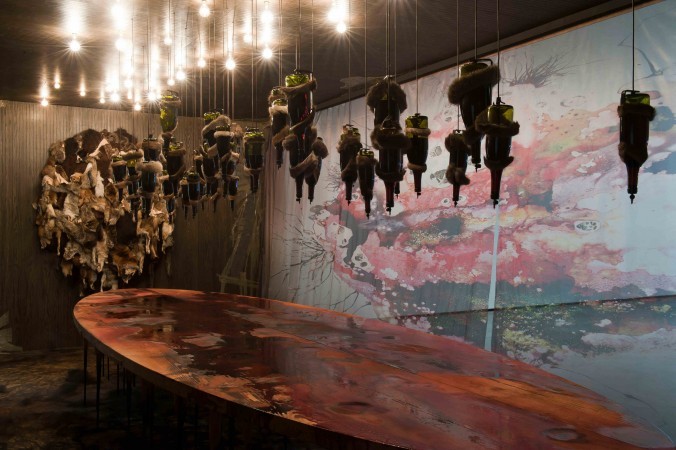Wangechi Mutu
13 Jul - 30 Sep 2012
WANGECHI MUTU
The Undreamt Descent
13 July - 30 September 2012
The second solo exhibition in the annual program of the Staatliche Kunsthalle Baden-Baden presents Wangechi Mutu, born in 1976 in Nairobi, Kenya. The collages, installations and videos of the New York-based artist are inhabited by strange, hybrid creatures, which are assembled of body and machine parts, hides and plants. She combines low-cost utensils such as rescue blankets, plastic bowls and bottles, which evoke such ambivalent feelings as cosiness or exposedness and disaster. The artist uses such signs, that have been reproduced a thousand times on the opaque surface of the illusionary media spheres, and she reconfigures them to new, auratic and, at times, disturbing collages. The outcome of such revisions draws the attention of the viewer on the corporeal violation of the female (black) body and its media representations.
Although her visual grammar and the material implementation repeatedly refer to her African origin, Wangechi Mutu is not a typical African artist. Rather than that her artistic approach signifies the impossibility of such straight forward attributions in a globalized world. Cultural identities are no longer simply determined by geographical origin, but they exist as hybrid constructs in a transitory space. The patchwork of her imagery is defined by pairs of contrast: profane and religious, brute and beautiful, poor and abundant.
A broader German audience knows Wangechi Mutu as the winner of the Deutsche Bank’s Artist of the Year award in 2010 and her subsequent solo show at the Deutsche Guggenheim Berlin. She has exhibited on a global scale with numerous exhibitions, i.a. at the Guggenheim Bilbao, Spain (2011), at the Art Gallery of Ontario, Canada (2010) and the Museum of Contemporary Art, San Diego, USA (2009).
The Undreamt Descent
13 July - 30 September 2012
The second solo exhibition in the annual program of the Staatliche Kunsthalle Baden-Baden presents Wangechi Mutu, born in 1976 in Nairobi, Kenya. The collages, installations and videos of the New York-based artist are inhabited by strange, hybrid creatures, which are assembled of body and machine parts, hides and plants. She combines low-cost utensils such as rescue blankets, plastic bowls and bottles, which evoke such ambivalent feelings as cosiness or exposedness and disaster. The artist uses such signs, that have been reproduced a thousand times on the opaque surface of the illusionary media spheres, and she reconfigures them to new, auratic and, at times, disturbing collages. The outcome of such revisions draws the attention of the viewer on the corporeal violation of the female (black) body and its media representations.
Although her visual grammar and the material implementation repeatedly refer to her African origin, Wangechi Mutu is not a typical African artist. Rather than that her artistic approach signifies the impossibility of such straight forward attributions in a globalized world. Cultural identities are no longer simply determined by geographical origin, but they exist as hybrid constructs in a transitory space. The patchwork of her imagery is defined by pairs of contrast: profane and religious, brute and beautiful, poor and abundant.
A broader German audience knows Wangechi Mutu as the winner of the Deutsche Bank’s Artist of the Year award in 2010 and her subsequent solo show at the Deutsche Guggenheim Berlin. She has exhibited on a global scale with numerous exhibitions, i.a. at the Guggenheim Bilbao, Spain (2011), at the Art Gallery of Ontario, Canada (2010) and the Museum of Contemporary Art, San Diego, USA (2009).

